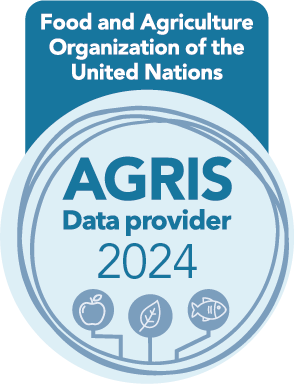Pollen Viability in Taro (Colocasia esculenta (L.) Schott) in Cuba
DOI:
https://doi.org/10.5281/zenodo.11968061Keywords:
fertility, pollen, taro, Colocasia esculentaAbstract
In taro, pollen availability or variability, and the number of clones that produce inflorescences, are not worldwide problems today. However, in Cuba, the appearance of inflorescence is critical, since the high-yielding accessions are not the ones that produce the inflorescences; it rarely or never happens, but when it does, pollen is not viable in most cases. Therefore, the aim of this paper is to evaluate fertility and viability of pollen in taro accessions (Colocasia esculenta). The germplasm accessions of the species, preserved at the Center for Tropical Crops Research (INIVIT) were evaluated during the 2015-2016 period. Staining by aceto-carmine glycerol jelly or pollen viability test was performed to 19 accessions selected for their inflorescences in field conditions. The result was expressed as the percentage with respect to the total number of pollen grains, using a descriptor of variations of pollen viability to determine if the accessions could be used as male parents in crop breeding programs. Five of the nineteen accessions evaluated were observed to produce viable pollen, which may be used as potential male and female progenitors in the genetic breeding program by species hybridation.
Downloads
References
Bradshaw, J. E. (ed.), (2010). Root and Tuber Crops. Handbook of Plant Breeding, 295. Springer, London. Retrieved fromhttps://fcaib.edu.ng/books/Agriculture/%5BJ.E._Bradshaw%5D_Root_and_Tuber_Crops_(Handbook_of_(BookFi.org).pdf
Hernández, J. A., Pérez, J. J. M., Bosch, I. D. y Castro, S. N. (2015). Clasificación de los suelos de Cuba 2015. Ediciones INCA, Cuba, 93 p. Retrieved from: http://ediciones.inca.edu.cu/files/libros/clasificacionsueloscuba_%202015.pdf.
Ivancic, A. (2011). INEA hybridization protocols, Retrieved from: www.ediblearoids.org/ PROJECTS/ WP3 Breeding.
Lagos, C., Creuci M., Vallejo F., Muñoz J., Criollo H., Olaya C. (2005). Caracterización palinológica y viabilidad de Physalis peruviana L. y Physalis philadelphica Lam, Agronomía colombiana. 23 (1): 55-61. Retrieved from: https://revistas.unal.edu.co/index.php/agrocol/article/view/19906.
Marks, G.E. 1954. An aceto-carmine glycerol jelly for use in pollen fertility counts. Stain Technol. 29:277, doi: https://doi.org/10.3109/10520295409115483
Milián Jiménez, M.; I. Sánchez; A. Morales; Y. Beovides; X. Xiques; M. I. Román; C. T. González; S. Rodríguez; E. Espinosa; K. Rodríguez; O. Molina; M. Cabrera Y D. Guerra. (2004). Tecnología para el manejo sostenible de los recursos fitogenéticos de especies de importancia económica en Cuba. Programa y resúmenes. XIV Congreso Científico. Instituto Nacional de Ciencias Agrícolas (INCA), Cuba. p. 178.
Ministerio de la Agricultura (MINAG) (2008). Instructivo técnico del cultivo de la malanga (Colocasia esculenta (L.) Schott y Xanthosoma spp.).
Ramachandran, K. (1978). Cytological studies on South Indian Araceae. Cytologia 43: 289-303, doi: https://doi.org/10.1508/cytologia.43.289 .
Ramírez, N. (2009). Correlaciones entre la fenología reproductiva de la vegetación y variables climáticas en los Altos Llanos Centrales Venezolanos. Acta Botánica Venezuélica. 32 (2): 333-362. Retrieved from: http://www.jstor.org/stable/41740892
Sharma, A.K., & Das, N.K. (1954). Study of karyotypes and their alterations in aroids. Agronomia Lusitana 16: 2348.
Srinivasan, S. Y Gaur, P.M. (2012). Genetics and characterization of an open flower mutant in chickpea. Journal of Heredity 103: 297-302, Retrieved from: https://academic.oup.com/jhered/article/103/2/297/885695
Downloads
Published
Issue
Section
License

This work is licensed under a Creative Commons Attribution-NonCommercial-NoDerivatives 4.0 International License.
You are free to:
- Share — copy and redistribute the material in any medium or format
- The licensor cannot revoke these freedoms as long as you follow the license terms.
Under the following terms:
- Attribution — You must give appropriate credit , provide a link to the license, and indicate if changes were made . You may do so in any reasonable manner, but not in any way that suggests the licensor endorses you or your use.
- NonCommercial — You may not use the material for commercial purposes .
- NoDerivatives — If you remix, transform, or build upon the material, you may not distribute the modified material.
- No additional restrictions — You may not apply legal terms or technological measures that legally restrict others from doing anything the license permits.






